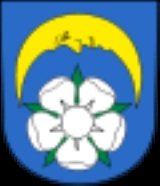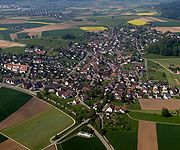
Neerach
Encyclopedia
Neerach is a municipality
in the district of Dielsdorf
in the canton
of Zürich in Switzerland
.
 Neerach has an area of 6 km² (2.3 sq mi). Of this area, 64.2% is used for agricultural purposes, while 5.7% is forested. Of the rest of the land, 17.7% is settled (buildings or roads) and the remainder (12.5%) is non-productive (rivers, glaciers or mountains).
Neerach has an area of 6 km² (2.3 sq mi). Of this area, 64.2% is used for agricultural purposes, while 5.7% is forested. Of the rest of the land, 17.7% is settled (buildings or roads) and the remainder (12.5%) is non-productive (rivers, glaciers or mountains).
The municipality is composed of the two villages of Neerach and Ried.
In the 2007 election the most popular party was the SVP
which received 51.5% of the vote. The next three most popular parties were the FDP
(13.1%), the SPS
(9.6%) and the CSP
(9.4%).
The age distribution of the population is children and teenagers (0–19 years old) make up 21% of the population, while adults (20–64 years old) make up 70% and seniors (over 64 years old) make up 9%. In Neerach about 86.7% of the population (between age 25-64) have completed either non-mandatory upper secondary education or additional higher education (either university or a Fachhochschule
).
Neerach has an unemployment rate of 1.34%. , there were 63 people employed in the primary economic sector and about 23 businesses involved in this sector. 111 people are employed in the secondary sector and there are 29 businesses in this sector. 310 people are employed in the tertiary sector, with 112 businesses in this sector.
The historical population is given in the following table:
Municipalities of Switzerland
Communes , also known as municipalities, are the smallest government division in Switzerland, numbering 2,596 . While many have a population of a few hundred citizens, the largest cities such as Zürich or Geneva also have the legal status of municipalities...
in the district of Dielsdorf
Dielsdorf (district)
Dielsdorf District is a district in the northwestern part of the Swiss canton of Zürich.Since 1871 the administrative center of the district is located in Dielsdorf. Previously the district was named Bezirk Regensberg, and its capital was Regensdorf, the only city in the district....
in the canton
Cantons of Switzerland
The 26 cantons of Switzerland are the member states of the federal state of Switzerland. Each canton was a fully sovereign state with its own borders, army and currency from the Treaty of Westphalia until the establishment of the Swiss federal state in 1848...
of Zürich in Switzerland
Switzerland
Switzerland name of one of the Swiss cantons. ; ; ; or ), in its full name the Swiss Confederation , is a federal republic consisting of 26 cantons, with Bern as the seat of the federal authorities. The country is situated in Western Europe,Or Central Europe depending on the definition....
.
History
Neerach is first mentioned between 1160 and 1169 as Neracho. In 1149, Ried was mentioned as Riete.Geography

The municipality is composed of the two villages of Neerach and Ried.
Demographics
Neerach has a population (as of ) of . , 9.4% of the population was made up of foreign nationals. Over the last 10 years the population has grown at a rate of 30.2%. Most of the population speaks German (92.9%), with French being second most common ( 1.6%) and English being third ( 1.6%).In the 2007 election the most popular party was the SVP
Swiss People's Party
The Swiss People's Party , also known as the Democratic Union of the Centre , is a conservative political party in Switzerland. Chaired by Toni Brunner, but spearheaded by Christoph Blocher, the party is the largest party in the Federal Assembly, with 58 members of the National Council and 6 of...
which received 51.5% of the vote. The next three most popular parties were the FDP
Free Democratic Party of Switzerland
The Free Democratic Party was a classical liberal political party in Switzerland. It was one of the major parties in Switzerland until its merger with the smaller classical liberal Liberal Party, to form FDP.The Liberals on 1 January 2009....
(13.1%), the SPS
Social Democratic Party of Switzerland
The Social Democratic Party of Switzerland is the largest centre-left political party in Switzerland....
(9.6%) and the CSP
Christian Social Party (Switzerland)
The Christian Social Party is a political party in Switzerland. The CSP is more social democratic than the CVP. With the moderate Christian left as its background, the CSP commits itself to social democratic and environmentalist political solutions...
(9.4%).
The age distribution of the population is children and teenagers (0–19 years old) make up 21% of the population, while adults (20–64 years old) make up 70% and seniors (over 64 years old) make up 9%. In Neerach about 86.7% of the population (between age 25-64) have completed either non-mandatory upper secondary education or additional higher education (either university or a Fachhochschule
Fachhochschule
A Fachhochschule or University of Applied Sciences is a German type of tertiary education institution, sometimes specialized in certain topical areas . Fachhochschulen were founded in Germany and later adopted by Austria, Liechtenstein, Switzerland and Greece...
).
Neerach has an unemployment rate of 1.34%. , there were 63 people employed in the primary economic sector and about 23 businesses involved in this sector. 111 people are employed in the secondary sector and there are 29 businesses in this sector. 310 people are employed in the tertiary sector, with 112 businesses in this sector.
The historical population is given in the following table:
| year | population |
|---|---|
| 1467 | 14 Households |
| 1634 | 382 |
| 1689 | 568 |
| 1791 | 483 |
| 1850 | 784 |
| 1900 | 555 |
| 1950 | 543 |
| 1970 | 718 |
| 2000 | 2,366 |

